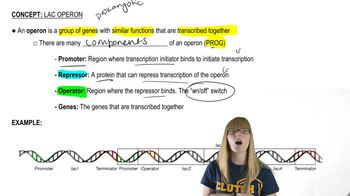Neelaredoxin is a 15-kDa protein that is a gene product common in anaerobic bacteria. It has superoxide-scavenging activity, and it is constitutively expressed. In addition, its expression is not further induced during its exposure to O₂ or H₂O₂ [Silva, G. et al. (2001). J. Bacteriol. 183:4413 4420]. What do the terms constitutively expressed and induced mean in terms of neelaredoxin synthesis?
Table of contents
- 1. Introduction to Genetics51m
- 2. Mendel's Laws of Inheritance3h 37m
- 3. Extensions to Mendelian Inheritance2h 41m
- 4. Genetic Mapping and Linkage2h 28m
- 5. Genetics of Bacteria and Viruses1h 21m
- 6. Chromosomal Variation1h 48m
- 7. DNA and Chromosome Structure56m
- 8. DNA Replication1h 10m
- 9. Mitosis and Meiosis1h 34m
- 10. Transcription1h 0m
- 11. Translation58m
- 12. Gene Regulation in Prokaryotes1h 19m
- 13. Gene Regulation in Eukaryotes44m
- 14. Genetic Control of Development44m
- 15. Genomes and Genomics1h 50m
- 16. Transposable Elements47m
- 17. Mutation, Repair, and Recombination1h 6m
- 18. Molecular Genetic Tools19m
- 19. Cancer Genetics29m
- 20. Quantitative Genetics1h 26m
- 21. Population Genetics50m
- 22. Evolutionary Genetics29m
12. Gene Regulation in Prokaryotes
Lac Operon
Problem 16c
Textbook Question
In the lac operon, what are the likely effects on operon gene transcription of the mutations described in a–e?
Mutation of the lacI gene affecting the allosteric site of the protein
 Verified step by step guidance
Verified step by step guidance1
Understand the role of the lacI gene: The lacI gene encodes the lac repressor protein, which binds to the operator region of the lac operon to inhibit transcription. The allosteric site of the lac repressor is where the inducer (allolactose) binds, causing a conformational change that prevents the repressor from binding to the operator.
Analyze the mutation: A mutation in the allosteric site of the lacI gene would likely affect the ability of the repressor protein to bind the inducer (allolactose). This could result in the repressor being unable to undergo the conformational change necessary to release from the operator.
Predict the effect on transcription: If the repressor cannot bind the inducer, it will remain bound to the operator, continuously blocking RNA polymerase from transcribing the operon genes. This would lead to a lack of transcription, even in the presence of lactose.
Consider alternative scenarios: If the mutation causes the allosteric site to mimic the induced state permanently, the repressor may never bind to the operator, leading to constitutive (continuous) transcription of the operon genes, regardless of lactose presence.
Summarize the outcomes: Depending on the specific nature of the mutation, the lac operon could either be permanently repressed (no transcription) or constitutively active (continuous transcription). The exact effect depends on whether the mutation prevents inducer binding or mimics the induced state.
 Verified video answer for a similar problem:
Verified video answer for a similar problem:This video solution was recommended by our tutors as helpful for the problem above
Video duration:
3mPlay a video:
Was this helpful?
Key Concepts
Here are the essential concepts you must grasp in order to answer the question correctly.
Lac Operon
The lac operon is a set of genes in E. coli that are involved in the metabolism of lactose. It consists of structural genes (lacZ, lacY, and lacA) and regulatory elements that control their expression. The operon is typically off when lactose is absent and is activated in its presence, allowing the bacteria to utilize lactose as an energy source.
Recommended video:
Guided course

Lac Operon Overview
LacI Gene and Repressor Protein
The lacI gene encodes the lac repressor protein, which binds to the operator region of the lac operon to inhibit transcription when lactose is not present. The repressor can undergo conformational changes when bound to allolactose, a lactose metabolite, allowing RNA polymerase to access the promoter and initiate transcription of the operon genes.
Recommended video:
Guided course

Proteins
Allosteric Regulation
Allosteric regulation refers to the modulation of a protein's function through the binding of an effector molecule at a site other than the active site. In the context of the lac operon, mutations affecting the allosteric site of the lac repressor can disrupt its ability to bind allolactose, potentially leading to continuous repression of the operon, even in the presence of lactose.
Recommended video:
Guided course

Regulation
Related Videos
Related Practice
Textbook Question
618
views


